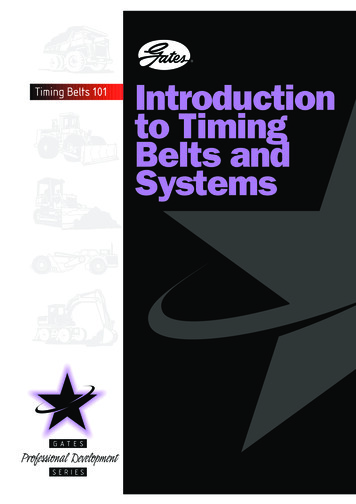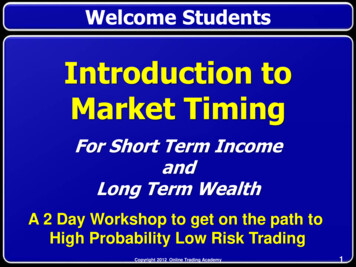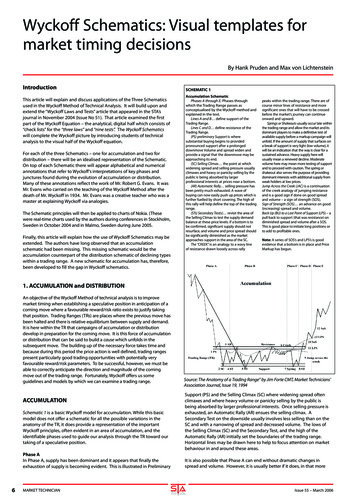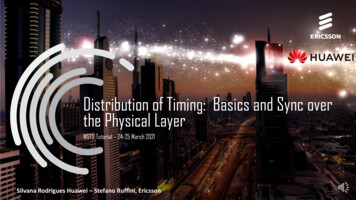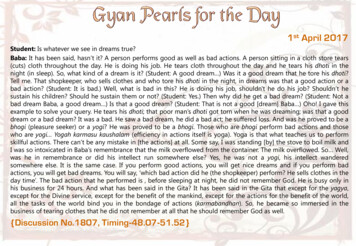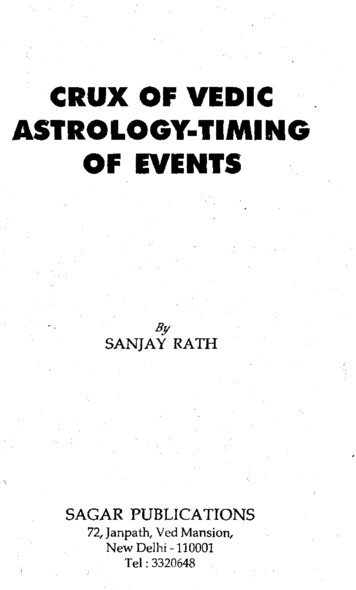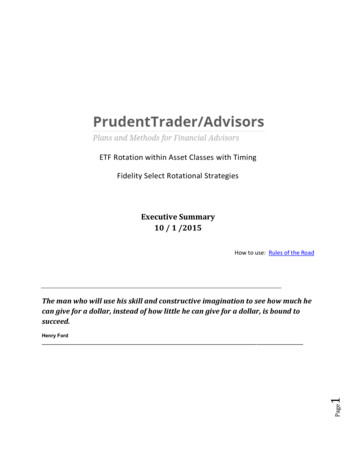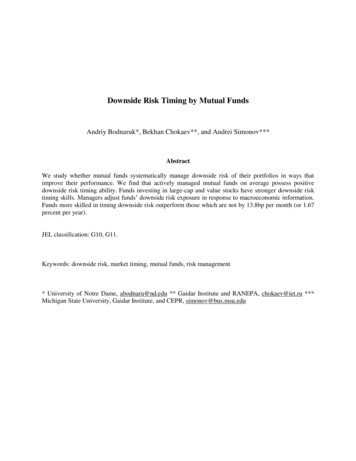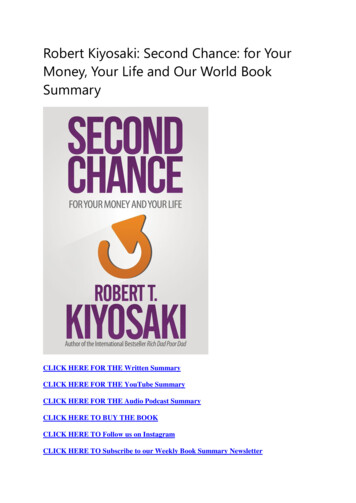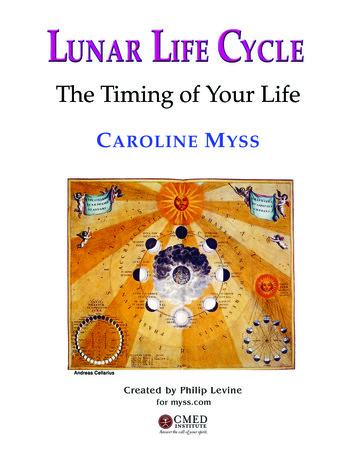
Transcription
The Timing of Your LifeC AROLINE M YSS
Copyright 2010 by Philip LevinePrepared for myss.com byPhilip LevinePhilipLevine@myss.com
Imagine. . .seeing your life, over the years of its unfoldment, through the highs andlows, the successes and failures, with a perspective on it all, how it all fitsinto some typical archetypal process, like the turning of the seasons. . .understanding the place of it all – even the gaps – and how it might fit anintelligent pattern. . .liberating yourself from guilt, regret or resentment, as you come to appreciate an alternative perspective that can uncover meaning in previous experience. . .feeling your participation in this larger process, with its own turning points,goals, and stages, and how that feeling of sharing in something greater cannourish and sustain you. . .
. . . Astrology is not merely a study of celestial cycles in themselves; it is a technique of interpretation of the meaning ofthese cycles with reference to the possibilities for growth inindividuals. . . Its essential purpose – when true to its highest and truest function in human affairs – is to indicate thepossibilities for individual development inherent in the significant turning points in the cycle of a human life.– Dane Rudhyar, The Lunation CycleLunar Life Cycle is dedicated to Dane Rudhyar(for more on Rudhyar, visit khaldea.com and beyondsunsigns.com)Phase Mandala 1974 Antony Milner
ContentsINTRODUCTIONiFIRST LUNATION CYCLE (December 1952 – June 1967)1DISSEMINATING PHASE (October 1955 – November 1959)3LAST QUARTER PHASE (November 1959 – November 1963)5BALSAMIC PHASE (November 1963 – June 1967)7SECOND LUNATION CYCLE (June 1967 – December 1996)11NEW MOON PHASE (June 1967 – October 1970)13CRESCENT PHASE (October 1970 – March 1974)15FIRST QUARTER PHASE (March 1974 – September 1977)17GIBBOUS PHASE (September 1977 – July 1981)19FULL MOON PHASE (July 1981 – August 1985)21DISSEMINATING PHASE (August 1985 – October 1989)23LAST QUARTER PHASE (October 1989 – July 1993)25BALSAMIC PHASE (July 1993 – December 1996)27THIRD LUNATION CYCLE (December 1996 – May 2026)31NEW MOON PHASE (December 1996 – March 2000)33CRESCENT PHASE (March 2000 – August 2003)35FIRST QUARTER PHASE (August 2003 – April 2007)37GIBBOUS PHASE (April 2007 – May 2011)39
ContentsFULL MOON PHASE (May 2011 – June 2015)41DISSEMINATING PHASE (June 2015 – July 2019)43LAST QUARTER PHASE (July 2019 – February 2023)45BALSAMIC PHASE (February 2023 – May 2026)47NEW MOON PHASE (May 2026 – )49
forCaroline MyssThis is your personal Lunar Life Cycle Report. It has been calculated for the followingbirth information:Dec 2 19527:49 am CST 6:00Chicago ILthen come in. We breathe in, and then out. Our hearts pump theblood, in and out. The seasons, the faces of the Moon, the alternation of day andnight. . . cycles rule so much of our lives. What if we could find a way to see ourlives in the same way, as a rhythmic in-and-out, or up-and-down?THE TIDES GO OUT,The meaning of our different times of life would be revealed if we could only see these asphases in the larger context of the cycles of our lives. The Lunar Life Cycle provides sucha perspective, and is based upon your own time and place of birth.The Lunar Life Cycle is based upon the monthly cycle of the Moon as it moves around theEarth. We are familiar with the changing face of the Moon when it emerges two or threedays after the New Moon as a thin crescent in the western sky at dusk. Over the next10-12 days the Moon’s light increases. Midway through the cycle the Full Moon appears,after which the light begins to wane with each passing day, until the Moon finally passesinto total darkness just before the next New Moon. This phenomenon is based upon thechanging relationship between the Sun, Moon and the Earth.i
IntroductionC. G. Jung recognized the significance of the cycle. Comparing the daily course of the Sunto the life of a human being, Jung wrote:At the stroke of noon the descent begins. And the descent means the reversal of all the ideals and values that were cherished in the morning. . . Itis as though it should draw in its rays, instead of emitting them. Lightand warmth decline and are at last extinguished. . . we cannot live theafternoon of life according to the programme of life’s morning – for whatwas great in the morning will be little at evening, and what in the morning was true will at evening have become a lie. . . Whoever carries overinto the afternoon the law of the morning. . . must pay for so doing withdamage to his soul.(Modern Man In Search Of A Soul)At the New Moon the Sun and Moon are in the same area of space with relation to theEarth and we do not see the Moon unless it eclipses the Sun:New Moon (day 1)By the First Quarter, the Moon has moved away from that area of space to a point whereit forms a right angle (90 degrees) with the Earth and the Sun. At this time we see half ofthe face of the Moon in light and half in darkness:First Quarter (day 8)ii
IntroductionAt the Full Moon the Earth is in between the Sun and Moon. When this alignment isstraight enough, we observe an eclipse of the Moon, in which the Earth’s shadow fallsacross the face of the Moon for a few hours. More often the Full Moon is notable becausethe face of the Moon is fully lit by the light of the Sun:Full Moon (day 15)At the third or Last Quarter we have a similar situation to the First Quarter, except nowthe Moon is on the other side of the Earth in relation to the Sun. But the angle is still oneof 90 degrees and we again see a face of the Moon which is half dark and half light:Last Quarter (day 22)This cycle has been significant since the dawn of human existence. It provided one of thefew repetitive patterns which allowed prehistoric humans to gain a sense of security andpredictability in a chaotic environment. (The others were the cycles of night/day and ofthe seasons. These provide the basis of the astrological houses and the zodiac, respectively.) The changing face of the Moon was worshipped as an aspect of the Feminine, asa goddess, a Queen of the Night who ruled over fertility and magic. Modern astrologyhas largely overlooked this important and meaningful cycle, with the notable exceptionof Dane Rudhyar.1Using the astrological technique of Secondary Progressions we are able to discover a basicstructure or pattern which underlies the changes and circumstances of your life. Thisis the main objective of all astrological counseling tools: to reveal an order or meaningbeneath or within what may often appear to be random or chaotic situations.1See The Lunation Cycle, Aurora Press, 1967, and The Lunation Process in Astrological Guidance byLeyla Rael.iii
IntroductionThe Lunar Life Cycle is one expression of the archetypal structure we call the cycle. WhileWestern civilization has mainly lost this important key, it has remained hidden withinastrology as its basic foundation. The signs of the zodiac, the houses, and astrologicalaspects are all based upon the cycle. Their meanings are derived from the particular placeor function each has within the cycle as a whole. Our lives unfold according to the samecyclic pattern. This is difficult for us to discern because there are so many cycles withmany different periods all overlapping or interpenetrating: 12-year cycles, 29-year cycles,1-year, 18-year, monthly, etc.The most basic structure of the cycle is derived from the fact that it consists of a beginning,a middle and an end. The monthly lunar cycle suggests by observation that the cycle canbe meaningfully divided into two halves. During the first half the movement is outward,as the Moon travels away from the area of space occupied by the Sun. As it does so, thelight of the Sun increases (waxes) on the face of the Moon. At the turning point symbolizedby the Full Moon, this movement reverses and the Moon begins approaching the Sun asthe reflected light on its surface wanes, until they meet again at the New Moon. Halfwaybetween these two turning points (New Moon and Full Moon) we can also see two otherimportant division points where light and darkness are equal on the Moon’s surface. Atthe First Quarter the light is increasing, while at the Last Quarter it is decreasing. Thesesimple astronomical observations provide the rationale for interpreting the lunar cycle’sphases.In addition to using these four turning points to define the lunar cycle and four of itsphases, four more phases can be determined by using the midpoints between New, FirstQuarter, Full and Last Quarter Moons. This gives the eight phases found in this Report:This Report projects this cycle symbolically over a 29-30 year period of your life. Thisperiod is based upon the lunar cycle, and the timing of its beginning, middle and end areuniquely yours. By using this key, you are able to identify your present phase, as well aspast and future phases and their meanings, determined by their place within the wholecycle. There is no specific type of circumstance or event which goes with any particulariv
Introductionphase: “Whatever happens in a person’s life during a particular phase of the lunationcycle, it plays the same role in the development of that life as the phase does in the cycle.”2Your first lunar cycle did not necessarily begin at birth, because most of us (unless wewere born at the New Moon) were born somewhere in the middle of a cycle. Thus yourfirst complete lunar cycle begins any time before age 30.What follows is a report which identifies the dates for each of the eight phases of yourLunar Life Cycle and explains the meaning of each phase. In addition, each cycle as awhole can be identified by a symbol, taken from An Astrological Mandala by Dane Rudhyar.3 This symbol, if contemplated, may in some way help you to interpret the mainquality or meaning of the cycle as a whole for you. It can be useful to refer back to thissymbolic purpose from time to time in order to better understand the direction of yourLunar Life Cycle in your life.NOTE: The descriptions of the phases of the Lunation Cycle are written for the conscious adult,capable of reflection and choice. These interpretations will usually not seem applicable to the earliestyears of your life, during babyhood and childhood, but they are included so as to provide the fullestarticulation of your Lunar Life Cycles.NOTE # 2: Nothing contained in this report is meant to suggest any foreknowledge of the timingof your demise.23Leyla Rael, ibid., p. 15.Vintage Books, New York, 1974.v
C AROLINE M YSSYOUR FIRST LUNAR CYCLESummer SolsticeNoonMidlifeInitiation TrialPhase 3:Full MoonNovember 1959 -November 1963Autumn EquinoxSunset"Retirement"Returning HomeFULL MOONLASTQUARTERPhase 4:Last QuarterFIRSTQUARTERNEW MOONWinter SolsticeMidnightBirth and DeathHomeINSIDE:The Lunar CycleOUTSIDE:The Seasonal CycleDaily CyclesHuman Life CycleInitiation JourneyYour dates1Phase 2:First QuarterSpring EquinoxSunriseYoung AdultLeaving HomePhase 1:New Moon
Caroline Myss’sFirst Lunar Life CycleDecember 1952 – June 1967You were born after the beginning of your first Lunar Life Cycle, during the Full MoonPhase of that cycle. In a sense, that is the Phase you are most “at home” in. The first entryinto the next following Phase in your life began the Disseminating Phase for this cycle,which lasted from October 1955 until November 1959.The color and fragrance radiating from the flower attract the insects whocarry on the sacred work of pollination. Psychic qualities also emanatefrom the flower, evoking love, passion, or healing in the hearts of itsadmirers. The fruit begins to form.Your Disseminating Phase occurred from October 1955, when the progressed Moon was in a waning sesquisquare with the progressed Sun or135 degrees behind it, until November 1959.It is now time for the plant which has flowered to spread its newly produced pollen intothe environment. Demonstration of whatever has been achieved or learned is called for:teaching, promoting, or some other kind of expressive effort. Since the last half of the cycleis a time for finding meaning, you may at this time be searching for a way to IMPRESSUPON OTHERS whatever has been realized during your Full Moon Phase. In doing sothese results can become related for you to a larger context which extends beyond theboundaries of your personal life. This effort can also help you to digest and assimilate thelearning from that phase. If your Full Moon Phase was disappointing, the DisseminatingPhase can be a time for reform.3
First Lunar Life CycleThis phase would correspond to the time when a building has been completed (Full Moon)and is occupied and serving the need for which it was originally created (or an alternativeneed if circumstances changed). In the human life cycle this phase would parallel thelate 40’s and early 50’s, considered to be the time of peak productivity, when experienceand maturity more than make up for waning stamina. This would be the time for one toconcentrate upon making his or her mark upon society, ideally having found his or hercalling.At first this expression may be stressful or the environment may resist your message,but by February 1957 the results of the first half of the cycle and your realizations whichoccurred during the Full Moon Phase should be coming together. This is a peak time forunderstanding and may present opportunities for expression which demand relativelylittle effort. It is not an opportunity to be wasted. Pour your energies into whatever youBELIEVE IN.You may have formally trained or studied in earlier phases in order to have reached thispoint or learned instead through your experiences. Now there may be a sense of innerpressure as the further distilling of what you’ve learned calls for organization and a possible shift in perspective required for its active expression. You can learn by teaching ordoing. The time for fruition is not quite here yet, but you must disseminate the productsof the earlier phases now if t
Caroline Myss’s First Lunar Life Cycle December 1952 – June 1967 You were born after the beginning of your first Lunar Life Cycl e, during the Full Moon Phase of that cycle. In a sense, that is the Phase you are most “at home” in. The first entry into the next following Phase in your life began the Disseminating Phase for this cycle, which lasted from October 1955 until November 1959 .
